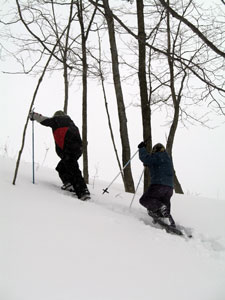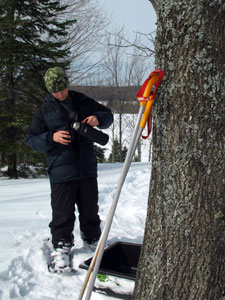
 |
| A good pair of modern snowshoes are easy to use and maintain. |
If you're an outdoorsman in the north, snowshoeing is just something you do every now and then. You might snowshoe for fitness or maybe you're looking for another activity that gets you out of the house. Whatever your reason, one thing is for certain — sooner or later, snowshoeing grows on you.
Trekking through the backcountry, if only for a morning, makes winter a little more enjoyable. The serenity and beauty of a snow-covered landscape is hard to describe. And while snowmobilers and cross-country skiers catch a fleeting glimpse of it, a snowshoer who leaves the beaten path might soon find himself immersed in a countryside that hasn't been visited since winter's onset.
One of the great things about snowshoeing is that it's relatively easy to learn and a great family activity. It is, after all, just walking with slightly different footwear. But, as simple as it is, it helps if you understand a few basics.
Follow the Leader
The importance of making a trail, for instance, is one thing that should be second nature to every snowshoer. There are real advantages to breaking one trail rather than several.
If you're in a group, the stronger snowshoers should take turns at trail breaking. Everyone else should follow single file in their tracks. This saves each member of the party from undue fatigue since you don't have to expend as much energy snowshoeing on a packed trail.
When it gets cold enough, a packed trail hardens too — sometimes to the point where a person could actually walk on it without snowshoes. This can also come in handy if anyone in the group tires of wearing them.
When my kids and I go out, we generally start off on trails we've made before, then when we feel like breaking off and exploring, we create new ones that branch off of it. After a while, if you snowshoe regularly, you'll have a network of trails that make winter travel easy and fun for snowshoers of all abilities.
Hills
Hills and slopes can also seem intimidating to new snowshoers. Luckily, two pieces of equipment help. The first is crampons, which grip the slopes. Most modern-style snowshoes have crampons attached.
 |
| It's best to take turns breaking trail when you're out in the deep snow. |
The next is piece of equipment that you shouldn't do without is ski poles. A good pair allows you to take pressure off your legs, balance and utilize upper body strength when ascending or descending slopes. They've got other less obvious uses too — for instance, you can check snow depth or probe for where a creek bank or snow-covered log ends.
With these things in your corner, ascending snowy slopes, even relatively steep ones, is not overly difficult. The key is to first pick a reasonable route and then make use of proven techniques.
The herringbone method is one. Basically, you step uphill with the toes of your snowshoes pointed about 45 degrees apart, so that they form a vee. Each small step is planted firmly in front of the other. At the same time, lean into the hill and use your poles for balance and support.
Similarly, you can also sidestep uphill. Again, step hard, use your poles for support, and lean into the hill. Then repeat as required.
A more aggressive way of climbing a steeper slope is to kick the toes of your snowshoes into the snow, ideally right to the boot. Then, step down hard so that you pack a step. Once your footing is secure, repeat the process with the other foot, step up, and do it again. Once again, use your poles.
While all of these methods work well, in my opinion, the easiest way is zigzagging or traversing up the slope. This method reduces the strain on your legs because instead of ascending, say 40 feet in 40 steps, you ascend that height in perhaps 160 steps because of the longer zigzag route. It's a bit slower but much easier on your muscles and certainly the best way to tackle bigger hills since, in essence, it reduces the angle of ascent.
Descending a hill is much the same as above, but in reverse. You can also try to slide down the hill on your snowshoes, but I leave that to the younger, more adventurous folks; I'd rather not end up as part of a snowball — or tree. There's really no great trick to coming down a slope other than choosing a reasonable route. If the slope is wooded, don't hesitate to use trees for support too.
Water Crossings
 |
| Ski poles can make climbing slopes much easier. |
When the old trappers used to traverse frozen ponds or lakes, they'd always undo or loosen their snowshoe harnesses and pack straps for as long as they were on the ice. The theory was that, if they went through the ice, they could get free of these things and pull themselves out. This makes good sense.
But, of course, it makes much better sense not to cross any questionable ice in the first place. If you plan on crossing ice, however, utilize the same rules of ice safety that you'd use at any other time and proceed with caution.
Be particularly suspicious of small ponds, especially ones with beaver activity or known underwater springs. Creeks, rivers, or any other moving water should simply be avoided. Ice on them is, at worst, dangerous and, at best, unpredictable.
Lesser Obstacles
Invariably, somewhere along the trail you'll find yourself confronted by a log across the trail. If you can, step around it. If you can't, don't use your snowshoes as a bridge -- if you do, bad things, like breaks of awkward falls, can happen.
Instead, step on the log with the center of your snowshoe directly over it. Then make your way over it. Again, use your poles for balance and support.
When crossing small creeks (a step or two across) I find it's sometimes best to take off my snowshoes altogether, throw them across and jump it. Or, if there's a rock or downed log spanning it, make use of them, provided, of course, it's safe.
Be Prepared
A snowshoer should also be prepared for the best and worst a winter's day can offer. This means being properly dressed for the outdoors. I won't go on about it too much, suffice it to say, that you should dress in layers -- light enough so that you don't overheat when moving, but heavy enough to keep you warm when you take a break. As always, base layers that wick away moisture are best. Gaiters or high waterproof boots are also good, and gloves and a good hat are a must.
 |
| It never hurts to stoke the furnace. |
Sunglasses, in my opinion, are vital on bright days. Sunlight bouncing off the snow is hard on unprotected eyes, especially over the course of a few hours. Headaches and snow blindness can result.
Your pack should also include high-energy snacks if you're going to be out there for any length of time at all. The need to keep the furnace stoked is never more important than in winter. Hot chocolate, granola bars and cookies are standard fare for our excursions — lunch is also part of the package if we're out for a day.
Though we generally retrace our trail on the way out, a GPS, compass and map are also a standard part of my kit. Winter, after all, is no time to get lost. While we're on the subject of electronics, take along a cell phone, if coverage permits.
Lastly, bring at least one extra snowshoe harness set or some bungee cords that could be rigged up as such in an emergency. There are few worse inconveniences than being stranded with broken snowshoes a couple of miles away from home. You'll get back, but you'll be exhausted and soaked before it's through.
The Last Step
Snowshoeing is a unique outdoors activity that keeps you fit, in touch with nature, and more appreciative of winter. And, somewhere along the way, when you're standing in the middle of a forest that no one has set foot in since November, you'll listen to the chickadees and ravens, regard the smooth contours and soft blueness around you and realize that the trail has led you to something very special.
Start off slow, learn the ropes, and enjoy every step along the way.
- 2279 views

